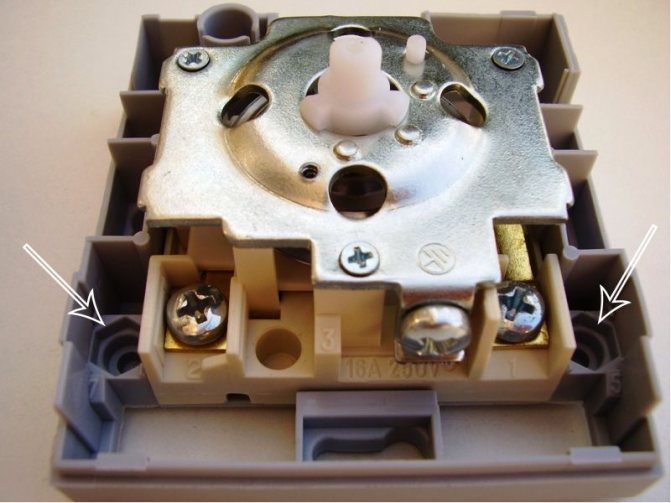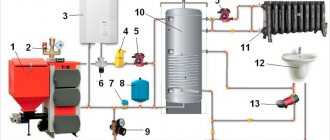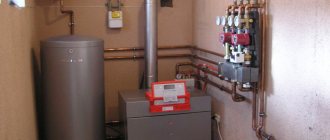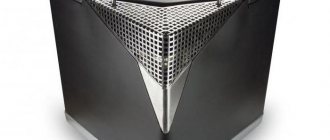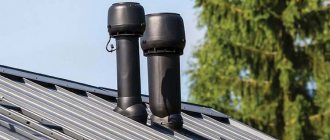Some simple models of electric boilers do not have a smooth power regulation by degrees, not to mention broader functionality. But even in the presence of degree-controlled regulation, the operation of the automation is based on measuring the temperature of the coolant in the supply and return of the boiler, which is not entirely effective: high accuracy cannot be achieved, high inertia is characteristic, i.e., a rather slow change in the air temperature in the house.
But the main thing is that in the absence of precise adjustments, a lot of electricity is wasted.
The problem can be solved by installing a special room thermostat (thermostat) for the electric boiler, the more expensive models of which measure the air temperature in the room and regulate the boiler operating mode in accordance with it, which is more correct and, most importantly, saves from 10 to 30% of electricity. Moreover, the price of the issue is only 800-1000 rubles for simple mechanical models or 3-5 thousand rubles for more functional programmable thermostats controlled from the phone.
What are thermostats for an electric boiler
What are they for and how they are used

Simple mechanical thermostat.
The temperature controller is a wired or wireless control panel that is mounted on the wall in any convenient place.
There are both simple mechanical models, the functionality of which is smooth temperature control by degrees (especially important for electric boilers with mediocre 3 or 6-step power control), and automatic programmable models with an information display, which allow you to set more than 50 boiler operation parameters, program them change for the next day and even a week.
Automatic thermostats allow you to adjust the boiler operation once and up to a whole or even several heating seasons.
In general, room thermostats for electric boilers perform functions such as:
- measurement, control and maintenance of a certain comfortable temperature of the working environment;
- transmission of signals to the electric boiler from any place convenient for the owner in the house;
- protection against overheating or freezing of the heating system;
- programming the operating mode for the next day or week;
- remote control from the phone if there is a Wi-Fi or GSM module in the thermostat;
- remote notification (including via a smartphone) about malfunctions and emergencies in the operation of the heating system.
Existing types
The settings made on the thermostat have priority over the settings of the electric boiler itself. The principle of operation of the device depends on the type of temperature sensor used in it:
1. Mechanical thermostats


The simplest models, the principle of which is based on the operation of membrane and capillary temperature sensors. They use substances that significantly expand at the slightest increase in temperature, placed in a capsule. The expanding substance, upon reaching the maximum temperature threshold, exerts pressure on the relay membrane, as a result of which the contacts open, the thermostat signals a partial or complete decrease in the power of the electric boiler.
The main disadvantages of such thermostats are simple functionality, limited by turning a round rotary knob to set the desired temperature, and a high error - up to 3-4 ° C.
2. Electromechanical


They have a more complex design, based on which special metal plates are used as a temperature-sensitive element, producing a micro-discharge when heated to a certain temperature. The micro-discharge activates an electromagnetic relay that controls the mechanical valve. In general, electromechanical thermostats have + - the same functionality, but a much smaller error, their cost is 20-40% higher.
3. Electronic
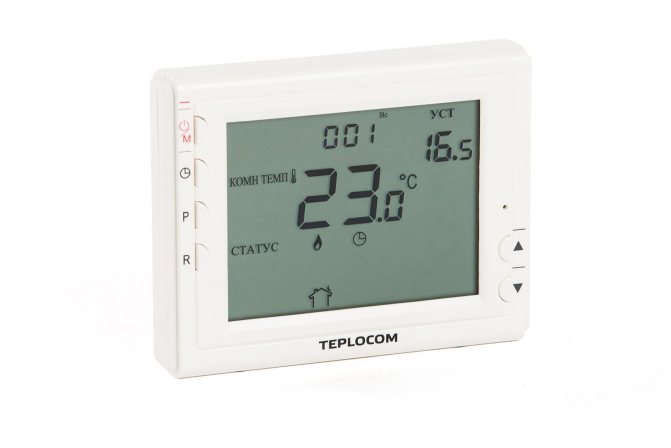

The most modern and multifunctional devices equipped with electrical boards (automation), often with external sensors: both internal and external (outdoor). They are able to maintain or change the operating mode of the electric boiler without human intervention. Allow a minimum error of up to 0.5-0.7 degrees. We recommend paying attention to electronic thermostats in view of their functionality and economy.
Automation of modern models is able to maintain the most economical mode of operation of the electric boiler, constantly adjusting its operation in accordance with the temperature in the working room, which completely prevents unnecessary consumption of electricity. After all, reducing the temperature by 1 ° C is up to 5% savings.
How to choose an external temperature sensor and organize weather-dependent boiler control
Advantages and disadvantages of electric boilers
Advantages:
- Today the most cheap gas is considered a type of fuel, but not every Russian has the opportunity to connect his house to a gas pipeline. One of the heating options for them is an electric boiler.
- Compactness, simplicity of design. The electric boiler has a design that does not need regular maintenance, like an oil boiler, and the constant presence of a person to maintain the heating system, as is the case with a solid fuel boiler.
- Low price. The device itself is much cheaper than the aforementioned equipment. In the case of purchasing a boiler for liquid fuel, you will have to pay more for tanks for a hinged burner and tanks for storing fuel.
- Ease of operation and installation. Due to the simple design of the electric boiler, installation will cost significantly less than boilers for liquid and solid fuels, which also need to install a chimney. No need for regular fuel supply.
- Security in operation, due to the absence of flammable fuel and open fire.
Disadvantages:
- Binding to the power line. The main disadvantage of electric boilers is the connection to the power line. In the event of a power outage, the boiler stops working.
- The high price of electricity.
- For boilers above 6 kW, separate 3-phase wiring is required.
- Scale formation on the heating element. To prevent limescale, additional cleaning filters must be installed.
To save fuel resources, it is recommended to use a waste heat boiler. Details:
How to choose a room thermostat for an electric boiler
Mounting and connection method
According to the technique of fastening and connecting to the electric boiler, wired and wireless devices are distinguished.
Wired thermostats can still be installed in any room, they can have any functionality, but they require a wired connection directly to the electric boiler. Their cost is lower, and in most cases the wire for connection is included in the kit.


Wireless temperature controllers consist of a control panel and a radio signal receiver connected to the electric boiler by a wired method. The advantages are obvious: when the thermostat is located in a room remote from the electric boiler installation site, there is no need to lay an additional electric wire through the whole house.
According to practice, a 433 or 868 MHz radio signal intended for household appliances does not affect other electronics in the house, it is transmitted without problems through any walls at a distance of 20 or even 30 meters. The disadvantage is the need for additional power supply to the control panel, usually 2 standard AA batteries.
Functionality
Standard simple models have only an on / off switch and a rotary knob (or buttons "+" "-") to set the temperature.
For substantial savings, it is best to opt for a more expensive programmable thermostat that will pay off in the first few months of use. It can be used to lower the room temperature to 15-16 ° C when everyone has gone to work, or 18-19 ° C at night. It is enough to configure several patterns of the electric boiler operation once, the duration of which can range from 8 hours to 7 days.
In addition, in addition to the built-in temperature sensor, programmable models are often equipped with additional remote ones, including those for heated floors.
Availability of Wi-Fi or GSM-module
The built-in GSM module allows you to receive SMS messages about the operation of the heating system or about an emergency that has occurred, which you can immediately resolve. Thus, the coolant will not freeze during a long absence of the owners.


The presence of Wi-Fi allows you to control the operation of the electric boiler through an application on a smartphone. Also, via a Wi-Fi network, you can connect the thermostat to a smart home system or link several additional temperature sensors (including a warm floor). The presence of Wi-Fi and GSM does not affect the efficiency and economy of the heating system, but increases the comfort of its use.
Protection and safety
In budgetary and even in some models of electric boilers in the middle price segment, basic safety elements such as overheating protection, frost prevention mode or protection against stopping the circulation pump may be missing. Nevertheless, all these elements are present even in many simple models of thermostats in the price range of 1,000-1,500 rubles.
Such security systems should not be neglected especially when temporarily living in a house, when the owners are absent for days or weeks, but the heating system maintains a positive temperature.
The lineup
So, there are five models in the Zota model line of electric boilers:
Model Econom
This is the cheapest model, but in terms of operational and technical characteristics it is not inferior to any other model. This is a fully automated design with a remote control panel. The boilers can be installed in heating systems with natural and forced movement of the coolant.
A distinctive feature is that the boiler and the process control unit are located in different buildings. They are installed separately and connected by wires. It should be added that Zota boilers of economy class with a capacity of 3-15 kW can operate both from power relay installations and from standard magnetic starters.
The automatics of the heater makes it possible to regulate the temperature regime in the range from + 40C to + 90C. These are the optimal limits that allow you to adjust the mode to save fuel consumption.
Note:
- Zota boilers of economy class with a capacity of 3-15 kW are adjusted manually.
- Units with a capacity of 18-45 kW are configured in automatic mode.
All boilers of this model are equipped with a self-diagnosis system. This allows you to identify in advance the flaws in heat engineering processes and breakdowns of units and parts.
Lux
The Lux model is considered the most demanded and popular. It is intended for heating houses with an area of 30-1000 m2.it is a fully automated electrical unit that is improved every year with new options and functions.
All boilers of this model are equipped with heating elements made of stainless steel tubes. The most advanced automatic equipment has been installed, which allows to save good money on fuel consumption.
MK
These are mini boiler rooms, which include:
- An electric boiler with characteristics like the Zota Lux boiler.
- Power block.
- Control block.
- Expansion tank of membrane type.
- Circulation pump.
- Security block.
- Pipe junction with shut-off valves.


And all this in one building. What does this give in practice?
- Firstly, due to the compactness of the device for mini boiler rooms, a large installation space is not required.
- Secondly, this configuration allows you to save on additional materials.
- Third, it is easy to install. Here it is only necessary to connect to the power supply network and connect the pipes to the circuits of the heating system of the house.
We add that MK Zota are produced with a capacity of 3 kW to 36 kW. For small country houses, this is the best option for heating.
The best known manufacturers and models: characteristics and prices
Cewal RQ-10


One of the simplest and most affordable mechanical thermostats from an Italian manufacturer. Despite the low cost, it is known for its build quality and reliability. The instructions for the device schematically and in detail indicate the installation and connection algorithm. The only drawback is the large hysteresis - up to 1.5-2.5 degrees, which is typical for all mechanical thermostats.
Cost: 800-1 150 rubles.
SKAT Teplocom TS-2AA / 8A


More advanced thermostat with an accuracy of up to 1 ° C. It has a micro-display for temperature indication, it is powered by 2 AA batteries (enough for 10-15 months). Differs in the presence of an economical night mode with automatic temperature decrease by 4 ° C and the presence of frost protection.
Cost: RUB 1,450-1,600
Danfoss ECtemp Next Plus


One of the best thermostats for an electric heating boiler in a price-quality-functional ratio. It is a modern electronic programmable thermostat with a stylish design and wide functionality. In addition to the built-in one, it has a remote wired temperature sensor for underfloor heating, which allows control separately from the air temperature in the room. Wide functionality, programming and availability of ready-made modes ("night", "away", etc.) allow you to maximize energy savings.
It is also distinguished by safety: the presence of protection against overheating and freezing, child blocking, monitoring the health of temperature sensors. According to the practice of installation and feedback from the owners, there were no cases of malfunction. In order to avoid malfunctioning, the assembly must fit exactly into the grooves of the plug connector.
Cost: 3 420- 3 900 rubles.
TEPLOLUX MCS-350
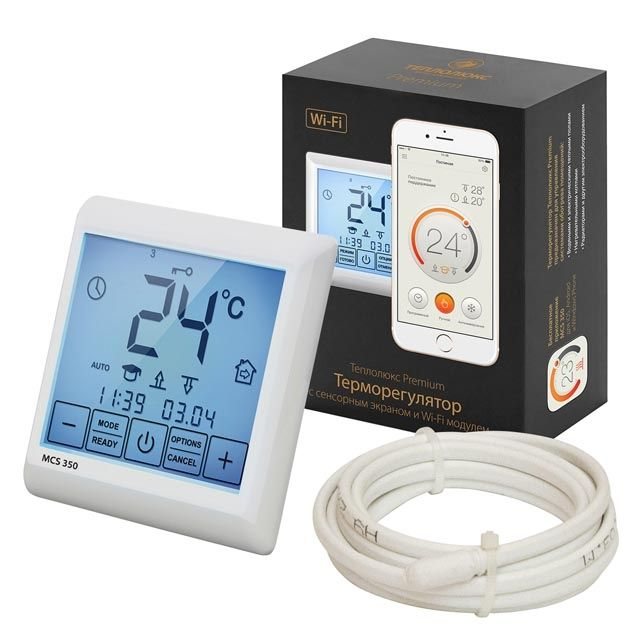

A modern multifunctional premium thermostat with a built-in Wi-Fi module and the ability to control using a special smartphone application. It features one of the broadest functionalities, an informative touch screen (with automatic locking) and a stylish design. The set includes both built-in and remote temperature sensors for simultaneous or separate control. Additionally, you can connect up to 32 temperature sensors.
There are template energy-saving operating modes and weekly programming, energy consumption statistics. The connection must be made via a modular contactor.
Cost: 5,900-6,200 rubles.
What is a modular contactor and what is it for
According to its functional purpose, the modular contactor KM belongs to the switching equipment for remote control of powerful loads operating with direct or alternating current. They break current circuits in several places at once, and this is different from electromagnetic relays, which break the circuit at only one point.
Quite often, modular contactors work in conjunction with auxiliary devices - attachments, thermal relays, interlocks and other modular devices. As a result of such combinations, equipment is obtained that has special properties and is capable of performing specified functions. So, when installing a delay module, a contactor with a delay function is obtained, and a thermal overload relay converts the contactor into the category of a magnetic starter. With the help of auxiliary elements, the capabilities of the main devices are significantly expanded, their operational characteristics are improved, and installation is simplified.
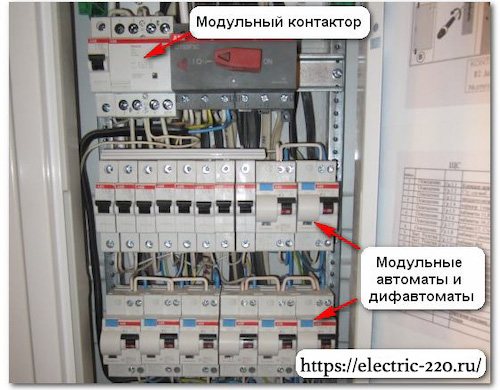

At their core, contactor devices are considered modified varieties of a starter, in which a thermal relay and a contact group are additionally present for starting an electric motor. Low voltage electromagnetic starters are reversible and non-reversible. The first option includes two identical contactors with the same rated current. It is equipped with a mechanical or electrical interlock, which prevents the main contacts from closing at the same time.
Protective functions in these devices are performed by electric thermal current relays and other similar devices. Low power electrical contactor, used as intermediate relay. It is designed for low-current circuits and has a large number of commutations. With the help of this device, it is possible to connect many additional sections and control their on-off.
Correct connection of the thermostat to the electric boiler
When choosing an installation site, it must be borne in mind that:
- installation near windows, ventilation or entrance doors is not recommended due to constant temperature changes;
- heated air masses are concentrated near the ceiling, closer to the floor the temperature is lower, therefore it is recommended to install the thermostat at a height of 1-1.5 m;
- Household appliances in the kitchen can generate heat, which affects the accuracy of measuring the overall climate in the workroom.
- it is not recommended to install too close to a frequently closed door;
- direct connection is not recommended if the load exceeds 10 A (connection is made via a modular contactor).
Connection instructions using the example of a mechanical Cewal RQ-10:
| Photo | Process description |
| Remove the rotator |
| Unscrew the screws by removing the front cover of the thermostat |
| Attach the device to the wall using the appropriate holes |
| Connect the ground. According to the diagram in the photo (click to enlarge), it is necessary to connect the thermostat contacts to the electric boiler board. |
| Individually... There can be a jumper between the “TA” contacts of the boiler board; it must be replaced with a two-core insulated cable with a conductor cross-section of 0.5-0.75 mm2. |
Modern thermostats are powered by AA batteries, but connection to the mains may also be required according to the diagram below:


Connection diagrams and a detailed algorithm are described in the instructions for each of the thermostats. However, each case is different and requires certain basic knowledge and skills. Therefore, the traditional advice - in case of difficulties and difficulties, contact the specialists.
Types of electric boilers


Photo source: stroyploshadka.ua
Electric boilers can be roughly classified as follows:
- for installation - wall or floor;
- purpose - only for heating (single-circuit) or for heating together with hot water supply (double-circuit);
- in terms of supply voltage and thermal power, respectively - single- (up to 6 kW) and three-phase (more than 6 kW).
Depending on the field of application, electric boilers are domestic and industrial.
Instructions for use
The attached instructions for the ZOTA electric boiler will allow you to quickly install and carry out the initial setup. Before connecting the boiler, preparatory work is carried out. If the power of the device is more than 3 kW, a separate electric line is laid to it
... It is not necessary to install an RCD, since it is found in almost all models (if not, select an automatic machine that is suitable for the current and voltage).
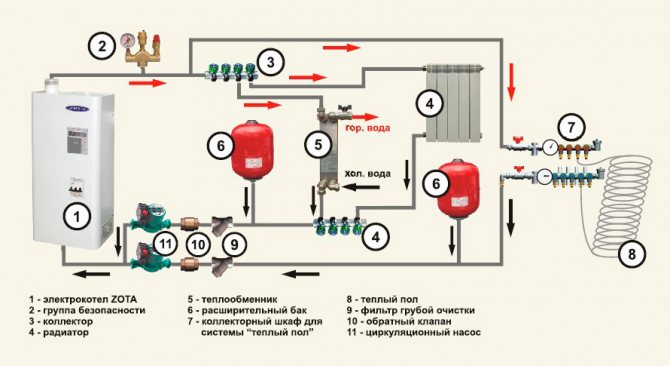

Heating circuit with a ZOTA electric boiler as a heating element.
When choosing a place for installing an electric boiler ZOTA, you need to make sure that there are no water vapor and aggressive gases in the room, and the air temperature is in the range from +1 to +30 degrees. Simple tap water or a special non-freezing liquid is used as a heat carrier. Boilers are installed strictly vertically. When connecting the equipment to the electrical network, it is necessary to provide grounding - it is connected to boilers and pipes.
Installation of ZOTA boilers is carried out according to the attached instructions - observing the distance to ceilings, floors and adjacent walls. The device must be in such a position that it does not obstruct its cooling (natural ventilation is used here). At the last stage, the boiler is connected to the heating system. Next, a tightness test and a test run are carried out.
Remember that the pressure in the heating system should not exceed the parameters specified in the passport. Failure to do so may result in equipment damage.







